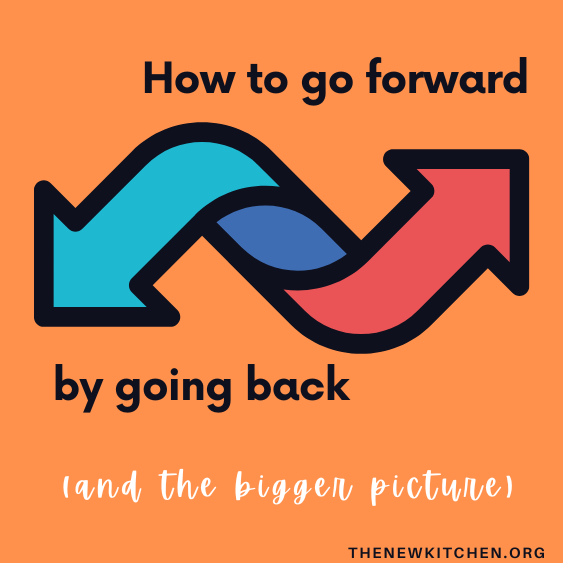This is the final part of a series on Food Marketing that explores why we need a different kind of smarts to stay healthy in an unhealthy food environment, i.e., “marketing-smarts.”
The last few posts talked about the dangerous influence of marketing when it comes to making food choices. You might remember the mac ‘n cheese ad in a previous post that illustrated the kind of subtle messaging that’s always pinging our brains.

As I became ever more aware of the harmful (but hard-to-spot) effects of marketing in the food world, I couldn’t help but notice the same thing in many areas of my life. I wonder if you’ve noticed the same thing.
For instance, Carolyn, one of our readers, shared an article revealing the dangers of seemingly innocuous black plastic spoons and spatulas. These attractive and inexpensive kitchen utensils are heavily marketed as critical accompaniments to non-stick cookware, also heavily marketed.
Not So Fast The problem is that many black utensils are made with recycled flame retardant-containing electronics, such as the outer casings of large TVs. While recycling is a good thing, it’s not good when the end product is used with food, since the toxins from flame retardants get leached into the food that we then ingest.(1)
 As for non-stick pans, their ads don’t reveal that they contain PFAS which are linked to a host of health issues like cancer, liver and kidney disease, altered immune and thyroid function, reproductive and developmental problems, insulin dysregulation, higher blood lipid levels, lower birthweight, and reduced vaccine response in children.” Yikes! (Learn more in this post.)
As for non-stick pans, their ads don’t reveal that they contain PFAS which are linked to a host of health issues like cancer, liver and kidney disease, altered immune and thyroid function, reproductive and developmental problems, insulin dysregulation, higher blood lipid levels, lower birthweight, and reduced vaccine response in children.” Yikes! (Learn more in this post.)
Now We Find Out After-the-fact discoveries of the dangers hidden in many modern products isn’t limited to just ultra-processed foods, black plastic and non-stick pans. We have found out, or are finding out, that many things carry hidden risks that are never advertised, e.g., “natural” gas, talcum powder, cigarettes, antibiotics, pesticides, asbestos, alcohol and many of the more than 80,000 different chemicals in our modern world.(2)
Get the (Bigger) Picture? The point here is that the effects of marketing aren’t limited to just a few random processed foods. We are saturated by marketing messages in almost every aspect of our lives.
This means that marketing is a systemic problem, which amplifies the importance of the “Buyer Beware” warning. It also highlights the importance of developing the necessary mental “muscle” to resist highly persuasive marketing.
Who’s In Control? In a population that so admires freedom and independence, isn’t it curious that we so willingly surrender both of those ideals in the marketplace? Ever consider how much of our lives are not really in our control, not just around food but also vacationing, transportation, exercise, health, social events and, particularly important at this time of year, gifting and holiday activities?
I once stopped to consider how many of my life decisions weren’t really my decisions at all! Between the expectations and desires created by marketing and those created by my peer group, I had to admit that fully 90 to 95% of my decisions weren’t my own!
Going Forward by Going Back The past few decades have seen us racing forward boldly and brashly, fully confident that progress always leads to a bigger, brighter and better future. We have been convinced that new and shiny is always better than old and familiar. So over the last several decade, we have thrown out a lot from the past that is still helpful and beneficial.
Maybe the real way forward lies in exercising keen discretion, independently assessing new vs old–and realizing that sometimes going forward means building on and adding to the past, not rejecting it entirely.
- I think about the set of plain stainless steel pans I bought nearly 20 years ago. Those pans are still going strong. Long gone, meanwhile, are my much more modern, non-stick pans in designer turquoise.
- I’m not worried about black plastic utensils because I still use the metal spatula my dad used to fry eggs every morning.
- My cell phone is practically an antique, but its limited functionality keeps me from becoming addicted to it.
- And yes, I know that applesauce in the store is very convenient and affordable, but I also know the incalculable value of picking my own apples, chopping them and turning them into the best-tasting applesauce that I love giving away to others!
It’s encouraging that recent years have seen people re-valuing discarded things like fermented foods, LP records, gardening, journal writing, fasting, and IRL (in real life) conversations and relationships. What about you? Are there some old-fashioned things you might like to resurrect?
As for the marketing we are continually subject to, are you gaining a greater awareness it? No doubt you’ve noticed that most of the marketing shenanigans have one thing in common: They are paid for by companies with a lot of marketing money.
You could say that living in the wealthiest country on the face of the planet sometimes has its drawbacks. All the money sloshing around in the economy makes massive marketing campaigns possible–and then we then have to navigate through the messaging to protect ourselves!
Speaking of protecting ourselves, there is one surefire way to do so:

I donate to a silly number of organizations because there are so many worthy causes, but also because I’m then kept abreast of their perspectives on a range of issues. I especially value non-profits’ perspectives because they don’t stand to make any money from their positions. In fact, most are run on a shoestring by people who are just dedicated to making the world safer, healthier and better overall.
So when you read about, e.g., the Red Dye 40 debate, who do you trust to determine if it’s safe for human consumption: the companies that stand to make millions and billions selling bright red food products or the non-profits alerting us to the potential health dangers that the industry is reluctant to reveal?
It’s Simple I remember reading an article in a small newsletter by a scientist devoting his life to saving butterflies. His article exposed the very real damage resulting from our widespread use of pesticides.
Reading the revelations of this lonely warrior, I had to question: Do I trust his research and warnings or the massively-funded research and hugely expensive promotions of the pesticide industry aimed at convincing us that there is nothing to fear from pesticides.
That’s when I was struck by the ingeniously simple rule: Always follow the money to know who really cares about us and our health!
Sources
(1) From Food & Wine and in the Atlantic here.
(2) Chemicals Dr. Kelly McCann just wrote an article about chemical exposure. I was astounded to find that we are potentially exposed to over 80,000 different ones. From shoe goop to repair a ripped sole and handy Post-It Notes to waterproofing for jackets and the paint that brightens walls, the benefits of modern chemicals are many. Now, after production has increased more than 15-fold since the 1940s and chemicals are found in almost every walk of life, we are discovering their not-so-beneficial downsides, including suspected neurogenerative and neurodevelopmental disorders. Her article was based on this research.
Alcohol See this article, “WSJ Interview with William C. Kerr: How Much Alcohol Can You Drink a Week and Still Be Healthy? Scientists are homing in on how much—or how little—you can consume without raising your risk for health problems
Gas Stoves Besides their climate effects, there is “mounting evidence that burning gas indoors can contribute to serious health problems because they emit “a host of dangerous pollutants.” (Although I do I love my gas stove!) “Enough Gaslighting: The Truth about Bad Industry Disinformation.” Union of Concerned Scientists, Catalyst, Summer, 2024.
